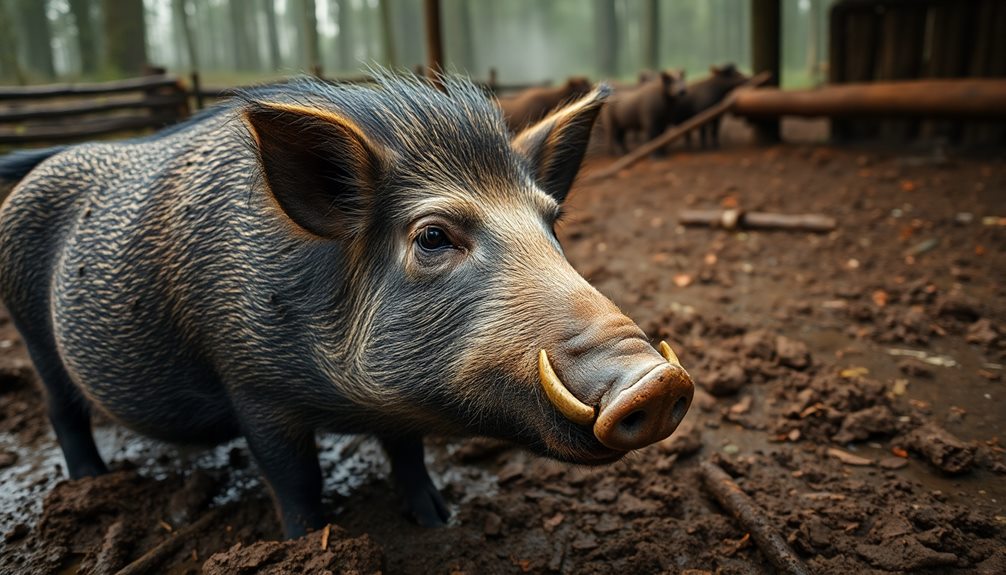Boar taint has a strong, unpleasant smell that you might describe as musky or earthy. Imagine the odor of dirty socks or spoiled meat; it can be pretty overwhelming! This smell arises when male pigs reach sexual maturity, mainly from compounds like androstenone and skatole. The scent can vary in intensity and often reminds people of wet hay or overripe fruit. For many, it's a turn-off when cooking with tainted meat, as that smell can linger. If you're curious about how this affects food choices or cooking tips, there's even more to discover!
Key Takeaways
- Boar taint has an intensely unpleasant, musky odor reminiscent of wet hay or overripe fruit.
- The smell features acrid undertones that can be nauseating, comparable to dirty socks or spoiled meat.
- It is primarily caused by compounds like androstenone and skatole produced during sexual maturity in male pigs.
- The odor becomes more pronounced in intact or uncastrated male pigs as they reach late growth stages.
- Cultural perceptions often link boar taint to disgust and food quality concerns in pork-eating societies.
Introduction
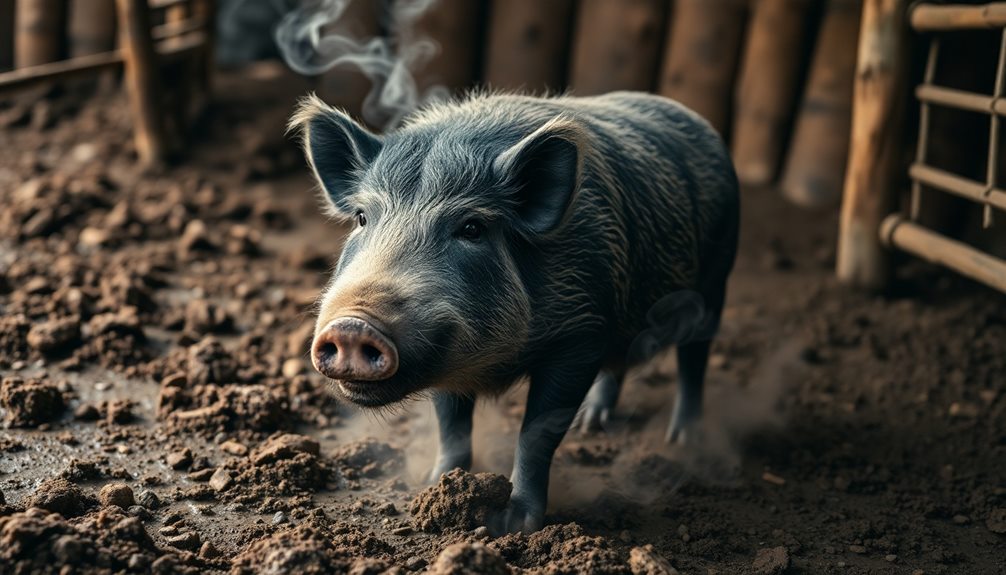
Boar taint often surprises those unfamiliar with it, as its distinctive odor can be quite overpowering. This phenomenon occurs when male pigs reach sexual maturity and produce certain hormones, leading to an unpleasant smell. If you're thinking about cooking pork, you might want to learn more about this topic. After all, nobody wants their meal to be ruined by an unexpected scent!
Understanding boar taint is important, especially if you're considering different types of pig meat. It usually becomes a concern when the meat comes from uncastrated male pigs. The hormones responsible for the smell, like androstenone, can linger in the meat, making it less enjoyable to eat.
You might even find that some people can't detect the odor at all, while others find it quite strong. This difference in perception can make discussions about pork quite interesting!
If you're curious about how to avoid boar taint or want to know which cuts of meat are best, you're in the right place. Exploring this topic will help you become more informed about your food choices and enhance your overall cooking experience.
Description of the Smell

The odor associated with boar taint can be intensely unpleasant, often described as musky or pungent. When you catch a whiff, it might remind you of strong, earthy scents, like wet hay or even overripe fruit. This smell isn't subtle, and it tends to linger, filling the air around you with an unmistakable presence.
Imagine walking through a barn on a hot day, where the mix of sweat and animal smells hits you all at once—that's pretty close to what boar taint is like.
You might also notice a somewhat acrid undertone, which can make your stomach turn. Some people compare it to the smell of dirty socks or spoiled meat, which isn't very appetizing. It can be overwhelming, especially if you're not used to it.
When cooking, the scent can dominate, making it hard to enjoy the meal. If you're ever in a situation where you encounter this smell, you'll know it right away. It's a unique experience that sticks with you—definitely not something you forget easily!
Understanding this odor can help you appreciate the importance of handling pork properly.
Source and Composition
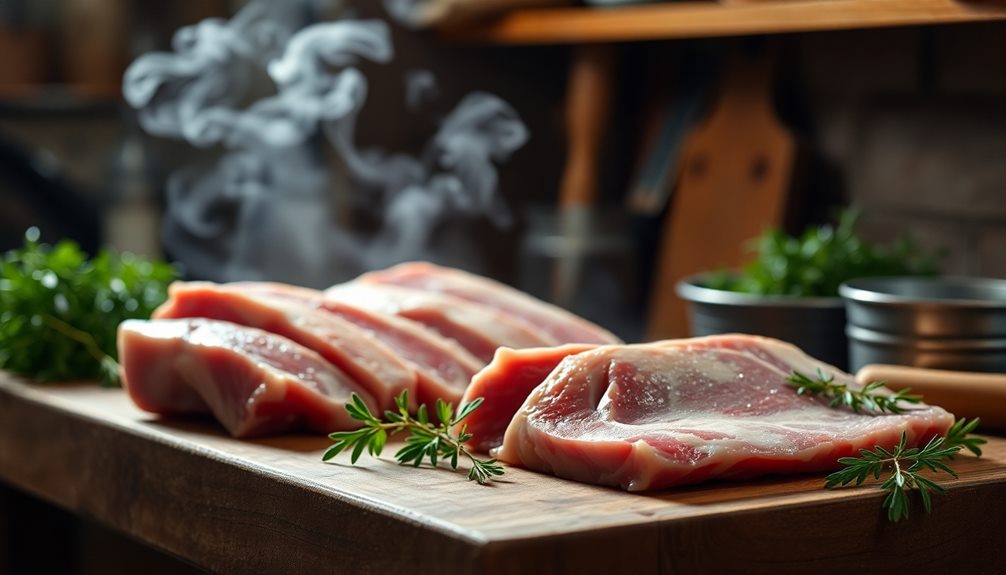
Originating from specific compounds produced in male pigs, boar taint is primarily linked to the presence of androstenone and skatole. These compounds create a unique smell that can be quite strong and unpleasant.
Androstenone is a pheromone, which means it plays a role in pig mating behavior. Interestingly, it has a musky odor that some people might find appealing, while others definitely do not!
On the other hand, skatole comes from the breakdown of tryptophan, an amino acid. It has a fecal odor that most people would agree isn't very nice. When male pigs reach maturity, their bodies produce more of these compounds, leading to the distinctive smell associated with boar taint.
When you think about it, these scents are nature's way of signaling that a pig is ready to breed. However, if you're raising pigs for meat, these odors can be a concern.
Understanding the source and composition of boar taint helps you appreciate the complexities of pig farming and why some farmers choose to castrate male pigs to avoid this issue altogether. It's a fascinating topic, isn't it?
Typical Scenarios or Environments
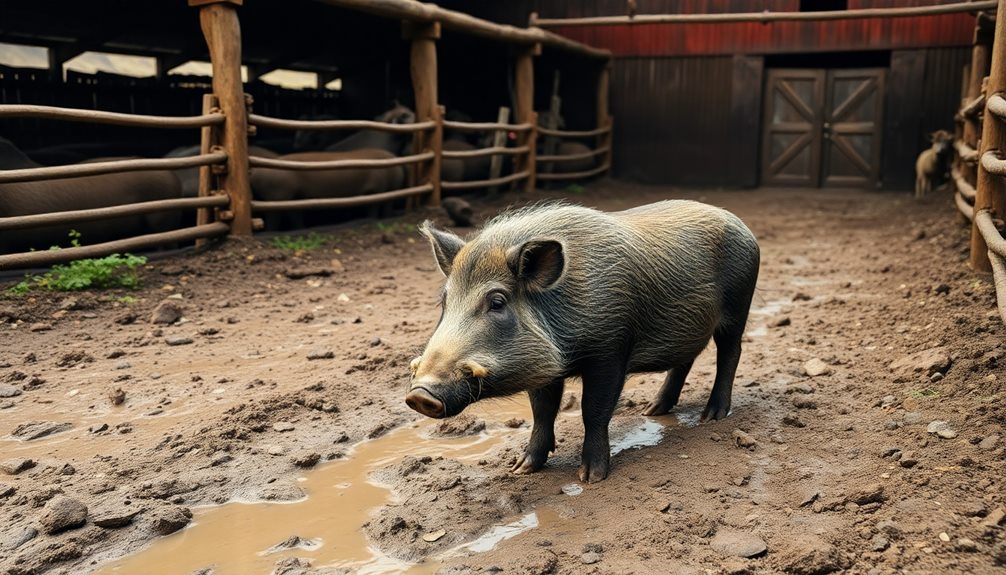
In many farming environments, particularly those focused on raising pigs for meat, the presence of boar taint can emerge during specific stages of a pig's development. As pigs mature, especially males, their bodies start producing certain hormones that can lead to this unique smell.
You'll often notice this during the late stages of growth when the pigs are nearing maturity. In a typical pig farm, you might find a mix of both male and female pigs, but it's the males that can present this issue.
When farmers keep males intact, or uncastrated, they might encounter boar taint more frequently. Picture a bustling barn with the sounds of pigs communicating and the earthy scent of hay; suddenly, the air shifts as the distinct smell of boar taint becomes apparent.
This odor can be tricky, as it may not just affect the pigs but also the overall environment. If you're working in such settings, staying vigilant helps in managing the situation.
Understanding when and why boar taint arises can make a big difference, ensuring quality meat and a pleasant experience for everyone involved.
Emotional or Cultural Associations
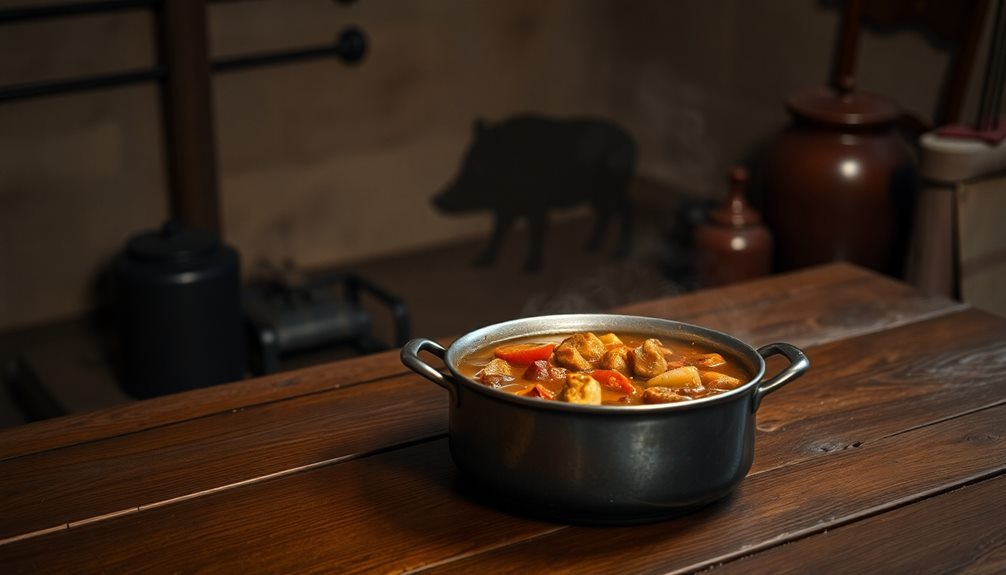
Many people associate boar taint with strong negative feelings, especially in cultures where pork is a staple food. The scent, which can be quite pungent, often triggers disgust and aversion. When you think about enjoying a delicious pork dish, the last thing you want is an unpleasant odor ruining the experience. For many, boar taint creates a mental image of spoiled or contaminated meat, leading to a strong emotional reaction.
In some cultures, where the tradition of eating pork runs deep, the thought of boar taint can also bring feelings of embarrassment or shame. If you've ever been at a family gathering, and someone mentions this smell, you might notice people shifting uncomfortably. It can even spark conversations about food quality and animal treatment, which are important topics to many.
Interestingly, this negative association can vary. In some areas, people may have a more open-minded perspective, viewing boar taint as just another aspect of animal husbandry.
Ultimately, how you feel about boar taint connects to your cultural background and personal experiences, making it a fascinating topic to explore!
Health or Safety Considerations

The negative associations with boar taint aren't just emotional; they also raise important health and safety considerations. When it comes to meat, you want to ensure it's safe and free from unpleasant odors. Boar taint, caused by certain compounds in male pigs, can't only ruin the taste but also signal potential health risks.
If you're cooking or eating pork, you might wonder if tainted meat can lead to foodborne illnesses or other health issues. It's important to note that while boar taint itself isn't harmful, it can indicate that the meat isn't being handled or processed properly.
If the meat smells off, you should definitely avoid eating it. Ensuring that pork is sourced from reputable farms or suppliers can help minimize any risks.
Additionally, proper cooking techniques can further reduce any chance of foodborne illness. Always cook pork to the recommended temperature, which helps kill harmful bacteria.
Final Thoughts

Understanding boar taint is crucial for anyone who enjoys pork. You mightn't think about it often, but this phenomenon can really affect your dining experience.
Boar taint is that unpleasant smell that some male pigs give off, making the meat less enjoyable. It comes from specific compounds that develop during their growth, especially if they aren't castrated.
Now that you know what boar taint is, you can make better choices when buying pork. If you're at the grocery store, look for labels that indicate the meat is from castrated males or from specific breeds known for lower taint levels.
You'll want to choose cuts that promise the best flavor without that unpleasant odor.
Frequently Asked Questions
How Can Boar Taint Affect Pork Meat Quality?
Boar taint can negatively affect pork meat quality by imparting an unpleasant odor and taste. When you cook or consume tainted meat, it diminishes your overall culinary experience, making it less enjoyable and appealing.
Are Certain Breeds More Prone to Boar Taint?
Yes, certain breeds, like Duroc and Berkshire, are more prone to boar taint than others. If you're selecting pigs for breeding, consider these factors to minimize potential issues with meat quality and consumer acceptance.
Can Cooking Eliminate the Smell of Boar Taint?
Cooking can reduce the smell of boar taint, but it often doesn't eliminate it completely. If you're sensitive to strong odors, you might want to consider alternative cuts or sourcing different pork to avoid it altogether.
How Do Farmers Manage Boar Taint in Livestock?
Farmers manage boar taint by selecting specific breeds, implementing castration, and using feed additives. They monitor hormone levels and ensure proper handling during breeding to minimize the risk of taint in their livestock.
Is Boar Taint a Concern in Wild Boar Populations?
Yes, boar taint's a concern in wild boar populations. It can affect meat quality, leading to unpalatable flavors. If you're hunting or consuming wild boar, be aware of this potential issue for a better experience.
